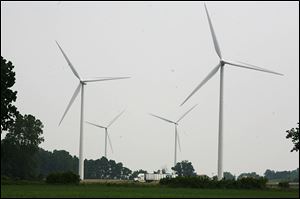
Strickland plan could 'green' Ohio
8/26/2007
Four wind turbines operate at the Wood County Landfill in Bowling Green. Wind power is a source of renewable energy.
COLUMBUS - Gov. Ted Strickland doesn't like the word "quota," but he said the proposal that he plans to put before lawmakers as soon as this week should help make Ohio a player in renewable energy technology.
Environmental groups raise their eyebrows, though, when talk of setting enforceable "benchmarks" for utilities to go "green" is accompanied by talk of an "advanced energy portfolio" that encompasses cleaner-coal - and nuclear technology.
"I want my plan to be a comprehensive approach," Mr. Strickland said. "It will deal with rates. It will deal with an advanced energy portfolio. It will deal with efficiency. There's no question in my mind that an emphasis on advanced energy will result in jobs being created and new industries being developed."
Environmental groups have called for a minimum standard requiring utilities to find 20 percent of their power from renewable sources by 2020.
They count wind, solar, low-impact hydroelectric, and landfill gases in that mix.
"I've heard that utilities think that's too aggressive, but when you look at the rest of the country, it's not an unreasonable expectation," Ohio Consumers' Counsel Janine Migden-Ostrander said.
"We can accept the 2020, but nothing less."
A study released last week by the nonprofit Environment Ohio estimated that 3,100 jobs could be created in the manufacture of products related to wind power alone if the state committed to going 20 percent wind by 2020.
Ohio gets about 87 percent of its electricity from coal-fired power plants that are expected to be the focus of tighter federal regulation.
"I understand the concerns related to nuclear power," Mr. Strickland said.
"I also understand the concerns related to global warming, and I believe there is an increased understanding that, if we're going to deal with global warming issues, we're going to have to have a very broad portfolio of approaches to this.
"I'm willing to accept whatever concerns may be associated with nuclear power because of what I consider to be the greatest, most immediate threat to the environment and humankind, which is global warming," he said.
He stressed that no utility at the table has indicated plans to build a new nuclear power plant, and that there will be nothing in his proposal specifically encouraging them to do so.
Inclusion of nuclear power as an advanced technology, however, might make it easier for a utility like FirstEnergy Corp., Akron parent of Toledo Edison, to meet whatever benchmarks the governor proposes.
"Nuclear is a nonemitting source, and for our company, nuclear produces 40 percent of the generation our customers' use," FirstEnergy spokesman Ralph DiNicola said. "But every power source has its issues and you have to deal with them accordingly.
"Clearly, we feel nuclear falls into the renewables camp, from a carbon dioxide standpoint, as a nonemitting source," he said.
Amy Gomberg of Environment Ohio said nuclear power shouldn't be mentioned in the same breath as renewable energy.
"The problem with coal is that it emits carbon dioxide and contributes to global warming, and there's high-level radioactive waste associated with nuclear power plants," she said.
"At Davis Besse, we were nearly a quarter of an inch away from a nuclear disaster in Ohio," she said.
"It would be short-sighted to consider nuclear power as part of the energy makeup of the future."
Blade business writer Jon Chavez contributed to this report.